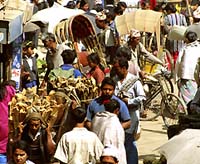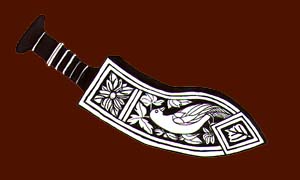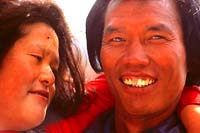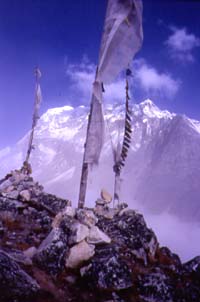
|
Kathmandu to the Langtang is a strenuous 26 day trek. Return trip to/from Vancouver including time in Kathmandu (YVR to YVR) is 36 days.
 The Langtang trek harkens back to the days when Nepal first opened its door to the world. One can begin walking from the dark alleys and bazaars in the heart of the city. At Sundarijal, in the outskirts, we begin to climb out of the Kathmandu valley through terraced hillsides. At Mulkharkha, six hundred meters higher, we stop for a rest. Below us spreads the valley, but it is what lies above and beyond the ridge top that lures us on. Through the rhododendrons on the crest, white peaks lurk. From the open pass the great Himalayan wall spreads before us.
The Langtang trek harkens back to the days when Nepal first opened its door to the world. One can begin walking from the dark alleys and bazaars in the heart of the city. At Sundarijal, in the outskirts, we begin to climb out of the Kathmandu valley through terraced hillsides. At Mulkharkha, six hundred meters higher, we stop for a rest. Below us spreads the valley, but it is what lies above and beyond the ridge top that lures us on. Through the rhododendrons on the crest, white peaks lurk. From the open pass the great Himalayan wall spreads before us.
For the next few days, we snake up and down along the ridge through Buddhist Sherpa villages of the Helambu region. We look out over a multitude of terraces and villages. At night the lights are like fireflies merging with the stars.
 The beauty of this trek is the range of choices that present themselves. Whichever way you ultimately go, you find endless variety. In deep forest, our ridge merges into the mountain side at Tharepati. If the group is acclimatizing well, and conditions are good, we can head up for a crossing of the Laurebina La at 4600 meters to the holy lakes of Gosainkund. Thousands of pilgrims climb here during the monsoon to bathe and honour the god Shiva. This is the high entrance to the Langtang valley. The view of Langtang Lirung and other 7000 meter peaks is breathtaking. The trail descends for two days through Tamang villages before joining the river route.
The beauty of this trek is the range of choices that present themselves. Whichever way you ultimately go, you find endless variety. In deep forest, our ridge merges into the mountain side at Tharepati. If the group is acclimatizing well, and conditions are good, we can head up for a crossing of the Laurebina La at 4600 meters to the holy lakes of Gosainkund. Thousands of pilgrims climb here during the monsoon to bathe and honour the god Shiva. This is the high entrance to the Langtang valley. The view of Langtang Lirung and other 7000 meter peaks is breathtaking. The trail descends for two days through Tamang villages before joining the river route.
If the conditions are not good enough to attempt the pass, we descend, dropping down a steep trail, to the Buddhist villages of the upper Tadi Khola valley. Rarely visited, the local people are extremely friendly, curious, and bemused by these strange visitors. Descending the river, the temperature keeps rising. The barley fields change to wheat and still further down, we pad our way through rice paddies. The people are of the Hindu faith. Most women wear bright red saris. Many men are wearing white dhotis. Shade giving pipal and banyan trees fan out like huge umbrellas over the villages while heat rays wave and shimmer over the river banks.

Within two days we arrive at the road head. Climbing onto the roof of an ancient bus, we rumble along ducking under the tree branches. We ford the river and sputter into Trisuli Bazaar, at 541 meters above sea level, 750 meters below Kathmandu. As we eat from a bag of fresh oranges and bananas, another bus pulls us right back into the hills to Dunche at 2000 meters in six hours. It is a very exciting ride! From Dunche, it is a short day's walk to Syabru, where we join the trail from Gosainkund.
 From here to the Alpine, we travel along the river in dense forest with vines, bamboo groves, and monkeys. The trees are full of birds and even the red panda is sighted here. The valley eventually opens up and we arrive at Langtang, built of wood and stone, Tibetan style. Yaks graze beneath prayer flags and along the paths lined with carved mantra stones. A half day up the valley lies Kyangin Gompa, at 3800 meters the last settlement and the home of the cheese factory. Rounds of excellent Swiss-style cheese line the shelves and can be bought by the kilo.
From here to the Alpine, we travel along the river in dense forest with vines, bamboo groves, and monkeys. The trees are full of birds and even the red panda is sighted here. The valley eventually opens up and we arrive at Langtang, built of wood and stone, Tibetan style. Yaks graze beneath prayer flags and along the paths lined with carved mantra stones. A half day up the valley lies Kyangin Gompa, at 3800 meters the last settlement and the home of the cheese factory. Rounds of excellent Swiss-style cheese line the shelves and can be bought by the kilo.
 Kyangin becomes our base for as many days as we can spare. Glacier walks and easy climbs abound. Intense blue sky and snow peaks are at our doorstep! One day hike is up to the Ganja La at 5106 meters. Shishapangma, 8027 meters rears its head above its shorter brothers and sisters, part way up to the pass. The fluted spire of Gangchempo is as perfect as a temple. Ganja La is a difficult pass, sometimes used by experienced parties to cross down into the Helambu region making a great circle of their trek.
Kyangin becomes our base for as many days as we can spare. Glacier walks and easy climbs abound. Intense blue sky and snow peaks are at our doorstep! One day hike is up to the Ganja La at 5106 meters. Shishapangma, 8027 meters rears its head above its shorter brothers and sisters, part way up to the pass. The fluted spire of Gangchempo is as perfect as a temple. Ganja La is a difficult pass, sometimes used by experienced parties to cross down into the Helambu region making a great circle of their trek.
 It is more likely that we descend back down the Langtang Khola beyond Syabru to Syabrubensi on the Bhote Kosi River. This is our roadhead. The bus awaits. It is one long amazing day back to Kathmandu. But we have come here mainly for the hot springs!
It is more likely that we descend back down the Langtang Khola beyond Syabru to Syabrubensi on the Bhote Kosi River. This is our roadhead. The bus awaits. It is one long amazing day back to Kathmandu. But we have come here mainly for the hot springs!

One is right among the boulders on the river's edge below town. We've had trouble getting some people to leave it! The other hot springs is an overnight trip up into the hills near the Tibetan border. The villagers stare amazed as if they've never seen westerners. On my first trip there, it was snowing and two monks were chanting, ringing bells and clashing cymbals at the pool edge. We lay submerged in bliss. Going there is a huge step back in time.
The juxtaposition of these timeless villages and the roadhead so close is unsettling -- it shows the speed at which Nepal is meeting the modern world. And speaking of the modern world, we have that bus ride I was talking about. There are thirty people on the roof, and the horns are blaring. Time to go!
|
|



 The Langtang trek harkens back to the days when Nepal first opened its door to the world. One can begin walking from the dark alleys and bazaars in the heart of the city. At Sundarijal, in the outskirts, we begin to climb out of the Kathmandu valley through terraced hillsides. At Mulkharkha, six hundred meters higher, we stop for a rest. Below us spreads the valley, but it is what lies above and beyond the ridge top that lures us on. Through the rhododendrons on the crest, white peaks lurk. From the open pass the great Himalayan wall spreads before us.
The Langtang trek harkens back to the days when Nepal first opened its door to the world. One can begin walking from the dark alleys and bazaars in the heart of the city. At Sundarijal, in the outskirts, we begin to climb out of the Kathmandu valley through terraced hillsides. At Mulkharkha, six hundred meters higher, we stop for a rest. Below us spreads the valley, but it is what lies above and beyond the ridge top that lures us on. Through the rhododendrons on the crest, white peaks lurk. From the open pass the great Himalayan wall spreads before us.
 The beauty of this trek is the range of choices that present themselves. Whichever way you ultimately go, you find endless variety. In deep forest, our ridge merges into the mountain side at Tharepati. If the group is acclimatizing well, and conditions are good, we can head up for a crossing of the Laurebina La at 4600 meters to the holy lakes of Gosainkund. Thousands of pilgrims climb here during the monsoon to bathe and honour the god Shiva. This is the high entrance to the Langtang valley. The view of Langtang Lirung and other 7000 meter peaks is breathtaking. The trail descends for two days through Tamang villages before joining the river route.
The beauty of this trek is the range of choices that present themselves. Whichever way you ultimately go, you find endless variety. In deep forest, our ridge merges into the mountain side at Tharepati. If the group is acclimatizing well, and conditions are good, we can head up for a crossing of the Laurebina La at 4600 meters to the holy lakes of Gosainkund. Thousands of pilgrims climb here during the monsoon to bathe and honour the god Shiva. This is the high entrance to the Langtang valley. The view of Langtang Lirung and other 7000 meter peaks is breathtaking. The trail descends for two days through Tamang villages before joining the river route.

 From here to the Alpine, we travel along the river in dense forest with vines, bamboo groves, and monkeys. The trees are full of birds and even the red panda is sighted here. The valley eventually opens up and we arrive at Langtang, built of wood and stone, Tibetan style. Yaks graze beneath prayer flags and along the paths lined with carved mantra stones. A half day up the valley lies Kyangin Gompa, at 3800 meters the last settlement and the home of the cheese factory. Rounds of excellent Swiss-style cheese line the shelves and can be bought by the kilo.
From here to the Alpine, we travel along the river in dense forest with vines, bamboo groves, and monkeys. The trees are full of birds and even the red panda is sighted here. The valley eventually opens up and we arrive at Langtang, built of wood and stone, Tibetan style. Yaks graze beneath prayer flags and along the paths lined with carved mantra stones. A half day up the valley lies Kyangin Gompa, at 3800 meters the last settlement and the home of the cheese factory. Rounds of excellent Swiss-style cheese line the shelves and can be bought by the kilo.
 Kyangin becomes our base for as many days as we can spare. Glacier walks and easy climbs abound. Intense blue sky and snow peaks are at our doorstep! One day hike is up to the Ganja La at 5106 meters. Shishapangma, 8027 meters rears its head above its shorter brothers and sisters, part way up to the pass. The fluted spire of Gangchempo is as perfect as a temple. Ganja La is a difficult pass, sometimes used by experienced parties to cross down into the Helambu region making a great circle of their trek.
Kyangin becomes our base for as many days as we can spare. Glacier walks and easy climbs abound. Intense blue sky and snow peaks are at our doorstep! One day hike is up to the Ganja La at 5106 meters. Shishapangma, 8027 meters rears its head above its shorter brothers and sisters, part way up to the pass. The fluted spire of Gangchempo is as perfect as a temple. Ganja La is a difficult pass, sometimes used by experienced parties to cross down into the Helambu region making a great circle of their trek.
 It is more likely that we descend back down the Langtang Khola beyond Syabru to Syabrubensi on the Bhote Kosi River. This is our roadhead. The bus awaits. It is one long amazing day back to Kathmandu. But we have come here mainly for the hot springs!
It is more likely that we descend back down the Langtang Khola beyond Syabru to Syabrubensi on the Bhote Kosi River. This is our roadhead. The bus awaits. It is one long amazing day back to Kathmandu. But we have come here mainly for the hot springs!
